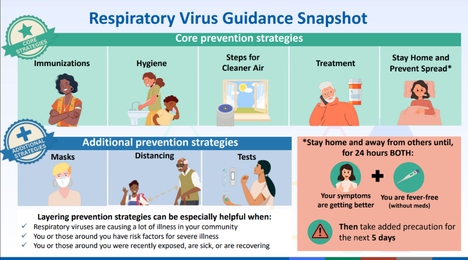Respiratory Virus Guidance
Each year, respiratory viruses are responsible for millions of illnesses and thousands of hospitalizations and deaths in the United States. In addition to the virus that causes COVID-19, there are many other types of respiratory viruses, including flu and respiratory syncytial virus (RSV). The good news is there are actions you can take to help protect yourself and others from health risks caused by respiratory viruses.

Please click here to view the CDC's Respiratory Virus Guidance
There are important steps you can take to protect yourself and others:
- Stay up-to-date with immunizations
- Practice good handwashing
- Take steps for cleaner air
- When you have a respiratory infection, use precautions to prevent the spread and seek medical care for testing and/or treatment
Additional prevention steps you can take to further protect yourself and others:
- wearing a mask
- physical distancing
- testing for respiratory viruses
Illnesses caused by respiratory viruses like COVID-19, flu, and RSV can make anyone sick. However, there are a range of risk factors that can increase a person’s chances of getting very sick (severe illness). Generally, people at higher risk of severe illness from respiratory viruses are older adults, young children, people with compromised immune systems, people with disabilities, and pregnant people.
Please click here to view Special Considerations for People with Certain Risk Factors for Severe Illness
COVID-19 Vaccination
CDC recommends the 2023-2024 updated COVID-19 vaccines. Please visit the CDC COVID-19 Vaccination page to find out if you are up-to-date.
- As of February 28, 2024 CDC recommends adults 65 years and over receive an additional updated 2023-2024 COVID-19 vaccine dose, which can provide additional protection to older adults, who are at highest risk of severe illness due to COVID-19
Data Resources
- Testing, cases and variants
- Hospitalizations and fatalities
- Vaccine data
- Long term care facilities
- Schools
Additional Resources
Schools PreK-12 & Childcare
NYS Paid Family Leave COVID-19 FAQ
Managing COVID-19 Symptoms at Home
*If you have emergency warning signs for COVID-19, call 911 or go to the emergency department. Emergency signs may include: trouble breathing, persistent pain or pressure in the chest, new confusion, inability to wake or stay awake, or pale, grey, blue-colored skin, lips or nail beds.

